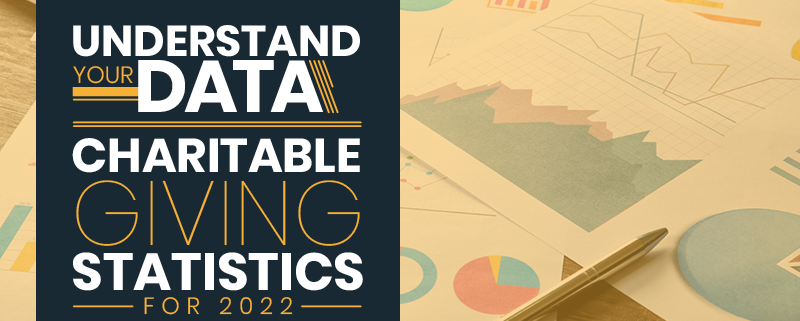Understand Your Data | Charitable Giving Statistics for 2024
Throughout the year, your organization collects data related to your donors, marketing campaigns, volunteers, and more. This information can help you decide how your organization should operate in the future. However, only examining your nonprofit’s own data is like attempting to solve a puzzle by only looking at the edges of a single piece.
Instead, you have to benchmark and compare your performance to get the bigger picture of where your strategies are working and where they could go further.
Charitable giving statistics help organizations, from nonprofits and higher education institutions to health care organizations and associations, gain a better understanding of larger industry trends. These statistics can help organizations put their own data into a greater context, providing a benchmark for their overall performance and giving insights into how they may want to proceed moving forward.
This report will explore a range of recent charitable giving statistics for four types of mission-driven organizations:
Each section will provide a key takeaway to offer additional context for each set of statistics. Use this information to determine what the data means and how it relates to your organization. Let’s get started.

Nonprofit Charitable Giving Statistics
In 2024, many nonprofits are still recovering from the setbacks of COVID-19 in 2020. Charitable giving statistics can give us a glimpse into how well nonprofits have responded to these challenges as well as how they intend to move forward.
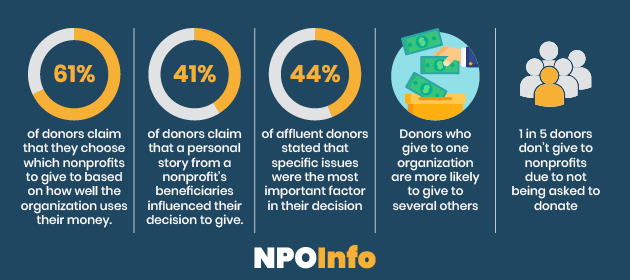
- December is still an important month for giving, but not as much as in previous years. Reports indicate that nonprofits receive 17-22% of their total annual fundraising in December, and giving levels depend heavily on organization type. Arts, animal rights groups, and higher education institutions have a steady flow of donations throughout December, while health, human service, and international organizations receive most of their donations on Giving Tuesday and December 31st.
- 61% of donors claim that they choose which nonprofits to give to based on how well the organization uses their money.
- Donors care about stories. 42% claimed that personal stories from a nonprofit’s beneficiaries influenced their decision to give.
- Nonprofits should educate donors about different ways to give. For example, studies conducted on planned giving found that over 40% of the donors surveyed learned about planned giving from a nonprofit organization. Studies also emphasize the importance of having conversations about planned giving early, when donors are in their 50s and 60s, rather than waiting until later in life to build long-term relationships prior to the bequeathment.
- The golden rule of donating continues to hold strong: only 20% of donors give after their first gift, but donors are 60% more likely to become recurring donors after their second gift.
- Despite the challenges of 2020 and 2021 due to the COVID-19 pandemic, the total giving rate is predicted to continue rising in 2022, increasing by 5.7%.
- For affluent donors, a nonprofit’s mission and their history with an organization almost equally influence their decisions to donate. According to recent surveys, 44% of affluent donors stated the issues a nonprofit addressed were the most important factor in their decision, while 44.5% claimed it was due to the organization.
- Donors often don’t give simply because they’re not asked. A survey of wealthy donors found that about 20% of participants did not give due to not being asked, while 22% didn’t give due to not having a connection with a charitable organization.
- Donors who give to one organization are likely to give to several others, as studies have found that 43.3% of wealthy donors give to five or more nonprofits.
- Ultimately, different nonprofits have had different experiences with the pandemic. While 45% of nonprofit leaders reported decreases in fundraising revenue, 31% reported increases in donations.
Takeaway
While COVID-19 has impacted charitable giving for nonprofits, many well known beliefs about nonprofit fundraising, such as the golden rule and the importance of year-end fundraising, continue to remain true. Overall, statistics show that nonprofits can benefit most from creating connections with supporters to encourage increased and more frequent donations.

Association Charitable Giving Statistics
Economic instability can result in multiple changes for associations. During these times, some individuals will flock to associations to improve their skills and connections in hopes of re-entering the job market with better prospects. By contrast, others will lack the funds to continue renewing their annual memberships, resulting in a decrease in overall association revenue.
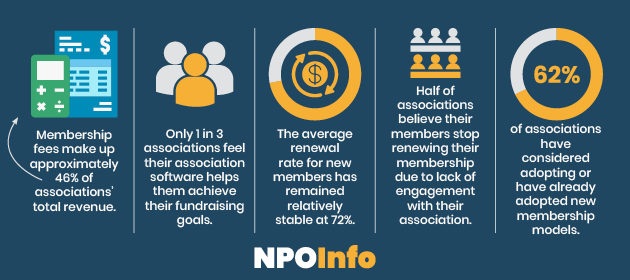
- Due to COVID-19, 50% of associations have reported having trouble reaching their fundraising targets.
- Membership fees are an important source of revenue for associations, making up approximately 46% of their total revenue. Plus, another 29% of revenue comes from fundraising events.
- Only 1 in 3 associations feel their association software helps them achieve their fundraising goals.
- However, despite this focus on decreased revenue, less than 50% percent of associations track their eCommerce transactions.
- Associations are seeing new highs in membership decreases with 47% of survey organizations reporting a decrease in members. Overall, smaller associations with limited budgets tend to experience decreases in membership more often than their larger counterparts.
- Despite these challenges, the average renewal rate for new members has remained relatively stable at 72%.
- While some may assume that young professionals looking to improve their skills would make up the bulk of association members, reports show that Baby Boomers actually participate the most in associations, making up 34% of association members. By contrast, Millennials make up 21% and Generation Z makes up just 8%.
- In terms of attracting support, word-of-mouth continues to be the most successful method with 57% of associations reporting it as one of their top three methods for attracting new members. This is followed by email (50%) and sponsored events (40%).
- Half of associations believe their members stop renewing their membership due to lack of engagement with their association. And 38% of associations believe that they have trouble communicating their beliefs and values to members.
- With these challenges, 62% of associations have considered adopting or have already adopted new membership models. Among new types of models, tiered is the most popular with 43% of associations changing their structure adopting it.
Takeaway
Associations are aware of the challenges their industry faces and are actively considering how to improve their marketing, organization structure, and offerings. However, the negative trends in these statistics seem to primarily impact smaller associations, while larger organizations have the resources to continually reach new audiences despite current challenges.

Higher Education Charitable Giving Statistics
Higher education as a whole has had to overcome the challenge of transitioning to remote and hybrid education. For many institutions, this change has resulted in reduced funding from previously reliable revenue sources, such as accommodation fees for student room and board.
Subsequently, many institutions have become increasingly invested in relevant charitable giving statistics as they strive to stay connected with donors to continue supporting their programs while managing the long-term impacts of COVID-19.
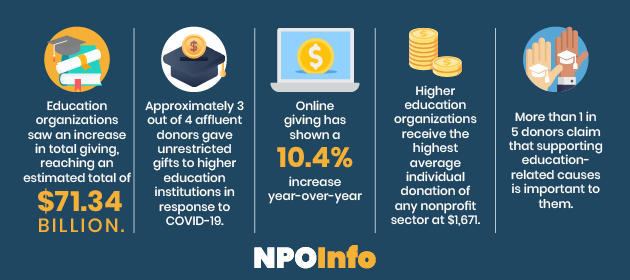
- Adjusted for inflation, education organizations saw an increase in total giving of 7.7% to reach an estimated total of $71.34 billion.
- Approximately 3 out of 4 affluent donors gave unrestricted gifts to higher education institutions in response to COVID-19.
- Online giving has become more important for higher education organizations, as reports show a 10.4% year-over-year increase in online giving.
- Higher education institutions continue to rely on a diverse set of fundraising revenue streams, with approximately 9.85% coming from individual donors, 7.74% from government grants, and 3.41% from fundraising events.
- Higher education organizations receive the highest average individual donation of any nonprofit sector at $1,671.
- Alumni are a major giving audience for higher education institutions, contributing approximately 26% of all higher education gifts.
- More than 1 in 5 donors claim that supporting education-related causes is important to them.
- 33.4% of women claim education is one of the causes that matters most to them, compared to 25.4% of men.
- Higher education has faced obstacles with online learning, and nearly 75% of university students report being unsatisfied with remote learning, which university leaders fear could lead to a generation of unengaged alumni and lower donations.
- Funding sources typically categorized as “others,” specifically donor-advised funds, have significantly increased their contributions to higher education institutions as compared to other types of donors, contributing approximately 11% of total gifts.
Takeaway
The statistics show an overall leveling off of funds with support primarily coming from alumni and family foundations with connections to specific universities. Professionals in higher education advise other leaders to be vigilant of long-term statistical trends, particularly warning universities that lack major endowments and high-level brand recognition about the potential loss of future major donors due to a lack of engagement caused by remote learning.

Healthcare Charitable Giving Statistics
The COVID-19 pandemic has caused a resurgence of interest in supporting health-related organizations. But has this interest translated to donations? The answer has also only become more complicated as the pandemic has stretched over multiple years, as these giving statistics show.
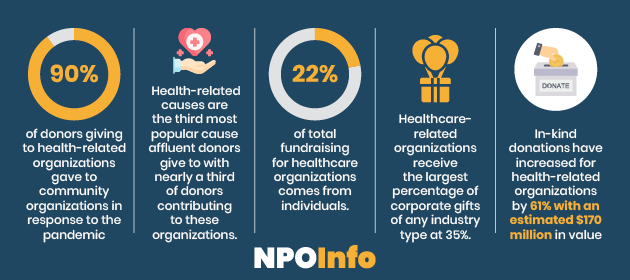
- Most individuals prefer to give to local healthcare and basic needs organizations, as 90% of wealthy donors gave to community organizations in response to the pandemic, while only 35.4% gave to national organizations.
- Contrary to assumptions, healthcare organizations as a whole actually saw a 3% decline in giving due to the pandemic. However, 42% of health service organizations saw an increase in donations. This is likely due to reduced participation in fundraising efforts for disease-specific organizations with objectives other than fighting COVID-19.
- In response to the pandemic, 49% of wealthy donors who gave to healthcare organizations did so to help hospitals and healthcare organizations obtain needed supplies.
- Wealthy donors also primarily gave unrestricted donations (74.8%).
- Health-related causes are the third most popular cause affluent donors give to with nearly a third of donors contributing to these organizations. This puts health-related causes behind only basic needs causes (57.1%) and religious organizations (46.9%).
- Donations from individuals are an important revenue stream for health-related organizations, making up 22% of their total funding.
- Healthcare-related organizations received the largest percentage of corporate gifts of any industry type at 35.3%.
- Healthcare organizations have seen a reduction in donors but an increase in gift sizes for years now, with 75% seeing fewer total donations but 46% earning more in dollars raised.
- Healthcare organizations tend to have lower than average donor retention rates when compared to other nonprofit sectors. However, the retention rate has been increasing in recent years. While there is only a 25% retention rate for first-time donors, this rises to a 66% retention rate for online multi-year donors.
- In-kind donations are also on the rise for health-related organizations, increasing by 61% with an estimated $170 million in value.
Takeaway
While there is a global interest in helping healthcare organizations, these charitable giving statistics show that individuals are primarily interested in supporting local organizations they have a relationship with first. This means health-related causes can most benefit from continuing to steward their donors to improve retention rates and gift sizes.
Resources
- Lilly Family School of Philanthropy
- Giving USA
- TrueSense Marketing
- BDO USA
- Blackbaud Institute
- Fonteva
- Marketing General
Wrapping Up
Charitable giving statistics help paint a wider picture of the overall giving landscape. Leaders at a variety of organizations can use them to put their own data into context, helping them make informed decisions about their future fundraising plans. Of course, this data is only useful if you understand how it relates to your organization’s specific situation.
Collecting, storing, and maintaining data are all continuous tasks that can take up a considerable amount of a nonprofit’s time. You can ensure your organization is maximizing its efficiency and putting its data to the best use possible with the right strategies. Here are a few resources to help your organization learn more about managing your data:
- What Data Should Nonprofits Collect? Overview & Top Tips. Your nonprofit can collect data on a variety of metrics, but what data actually matters to your organization? Learn more about collecting data with these top tips.
- The Nonprofit’s Ultimate Guide to Data Append Services. The more you know about your donors, the better you can fundraise. Explore how data append services can transform your nonprofit’s fundraising strategy.
- The Fundraiser’s Guide to Improving Nonprofit Data Hygiene. Your data is only useful if you can understand it. Learn how to keep your data organized and useful with this guide to nonprofit data hygiene.

